![V0045094 Ahalya the nymph being released from a curse by Rama and LakCredit: Wellcome Library, London. Wellcome Imagesimages@wellcome.ac.ukhttp://images.wellcome.ac.ukAhalya the nymph being released from a curse by Rama and Lakshman. Chromolithograph by R. Varma.By: Ravi VarmaPublished: [after 1900]Copyrighted work available under Creative Commons by-nc 2.0 UK, see http://images.wellcome.ac.uk/indexplus/page/Prices.html](https://fdnlife.com/wp-content/uploads/2019/11/Ahalya_rama.jpg)
By Ben Masterson & Marie-Berdine Steyn
TOP READS >
With religious history among humanity spanning several thousand years, it’s no wonder religious books such as the Bhagavad Gita, Tanakh, Bible, Quran, and Tripitaka – to name but a few – have been extensively used in trying to uncover many fascinating artifacts and relics throughout the ages. Most of course, with the interest in trying to ‘proof’ that the religious book in question is a work of fact and not fiction.
Though the reason behind searching for religious artifacts might be questionable, finding these is of great significance to archaeologists and religious believers alike. There will always be those who want to proof the validity of their religious book(s) and believes, while others stand firm to question and find proof to the contrary. When it comes to science and archaeology, one has to remain objective, with the first line of inquiry being the uncovering of artifacts and evidence to prove or disprove a theory, belief, or assumption.
As such, biblical and religious archaeology became a popular field of study in the last century, with various artifacts uncovered and attributed to the ancients. During this festive season, we invite you to enter and explore the magical and wonderful world of religious archaeology as we attempt to uncover the most fascinating religious artifacts.
THE ARK OF THE COVENANT
Are you fond of the infamous Indiana Jones film, ‘Raiders of the Lost Ark’? Most people find the movie fascinating for its search of one of the most famous biblical artifacts of all time – described in great detail in The Holy Bible and Tanakh.
To the early tribes of Israel, the Ark of the Covenant meant everything. It’s no wonder many a Biblical Archaeologist has searches fervently for it.
When one reads the Christian Bible or Jewish Tanakh, it is noted that Moses was instructed by his God (the God of the Israelites was known as YHWH (Yahweh) in those times) to build the Ark of the Covenant when Moses was praying to God on Mount Sinai. This was after God YHWH delivered the Israelites from slavery under the Egyptians.
Although made of wood, the Ark was overlaid with pure gold and had two golden cherubim’s mounted on its cover. Inside was only four items. The most important being the two stone tablets with the Ten Commandments – said to have been written by the finger of God – followed by Aaron’s rod that budded as a sign of the power of God. And yes, a bowl of manna. (Up to this day, nobody is sure what manna was.)
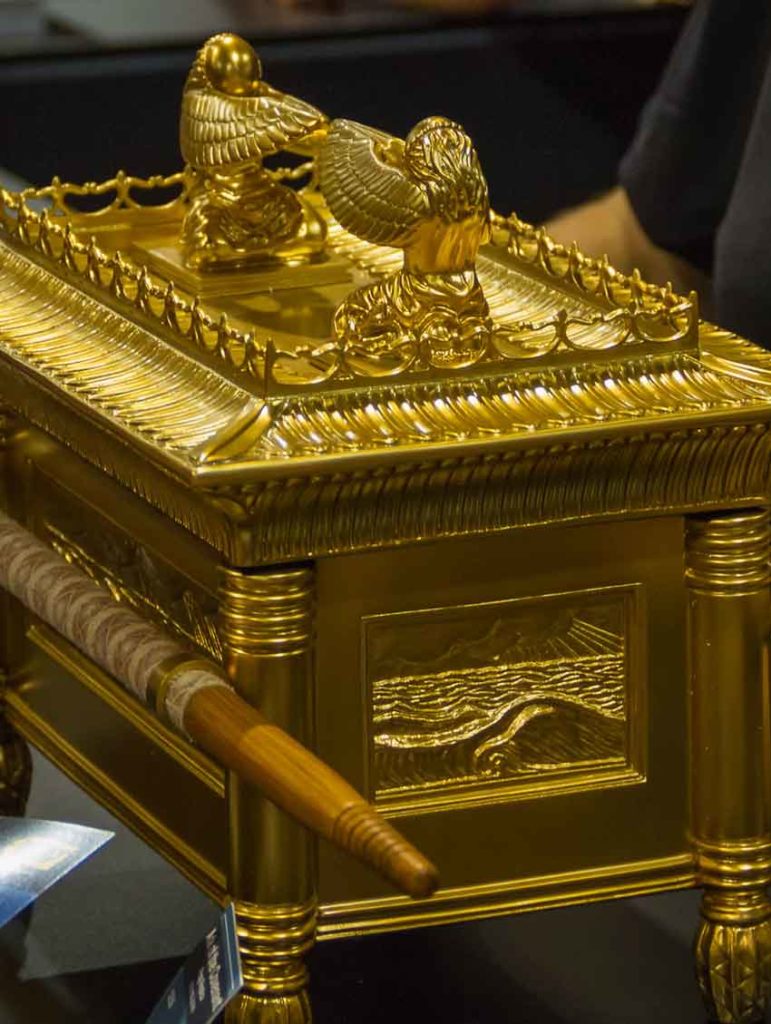
Photo credit: Chris Favero on Visualhunt /CC BY-SA
The Israelites connection to the Ark is said to be up until the reign of King Josiah, which was in and around 587 BC. Then, all of a sudden, it disappeared from history!
No record exists as to if it was taken by the Babylonians when they destroyed Jerusalem and King Solomon’s Temple. The current belief is that the Ark of the Covenant resides on a small island in Lake Tana in Ethiopia, guarded by virgin monks.
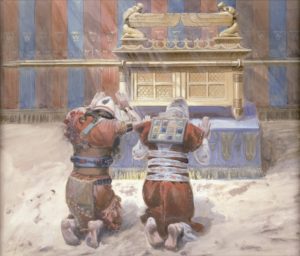
According to ancient Ethiopian scriptures, the ark was ‘stolen’ by Menelik, the son of the Queen of Sheba and King Solomon, to prevent it from falling into the hands of the Babylonians. The truth is though; nobody is allowed to see it, never mind come close to it. (This has raised suspicion among archaeologists and scientists around the world, eager to study and assertion the Ark in Ethiopia’s authenticity.)
A scholar, one Edward Ullendorff, claimed to have seen it during World War II but declared it a fake. The reason why was never mentioned, and until today nobody is certain if the Ark of the Covenant in existence in Ethiopia is fact or fiction.
![ANCIENT RELIGIOUS ARTIFACTS - A WORLD OF WONDER AND MAGIC 3 V0045094 Ahalya the nymph being released from a curse by Rama and LakCredit: Wellcome Library, London. Wellcome Imagesimages@wellcome.ac.ukhttp://images.wellcome.ac.ukAhalya the nymph being released from a curse by Rama and Lakshman. Chromolithograph by R. Varma.By: Ravi VarmaPublished: [after 1900]Copyrighted work available under Creative Commons by-nc 2.0 UK, see http://images.wellcome.ac.uk/indexplus/page/Prices.html](https://fdnlife.com/wp-content/uploads/2019/11/Ahalya_rama.jpg)
Photo Credit By Raja Ravi Varma
THE RIG VEDA
(BOOK OF THE MANTRA)
The Hindu book of Rig Veda, meaning amongst others wisdom, vision, and knowledge, is probably one of the oldest and most well-known books of the Hindu religion. Being one of four Vedas, the philosophy and guidance it offers to its followers form the basis of the early, ancient Hindu religion. Organized into ten books, The Rig Veda is made up of a collection of 1,028 hymns that mostly contains praises to specific deities, but there also are certain books that take on a philosophical approach that emphasis virtue in society and other issues.
The original Veda custodians, the Brahmins, learned Rig Veda verses by heart, and were then transmitted orally by them for thousands of years before officially being written down in and around 1,500 to 1,000 BC in Vedic Sanskrit.
The oldest remaining manuscript, written down during Adi Shankaracharya’s 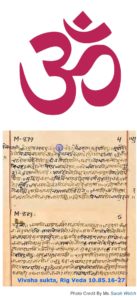 time, dates back to 1,500 to 700 BC. Though, some sources say it goes even as far back as 1,900 to 1,100 BC. Several versions of the Rig Veda are in existence, but only one copy of the original manuscript still exists. These scripts, written in Sanskrit, were discovered in Rajasthan in the 1800s.
time, dates back to 1,500 to 700 BC. Though, some sources say it goes even as far back as 1,900 to 1,100 BC. Several versions of the Rig Veda are in existence, but only one copy of the original manuscript still exists. These scripts, written in Sanskrit, were discovered in Rajasthan in the 1800s.
It is suspected that the Nazi artifact hunters stole the original during World War II. One can imagine then why The Rig Veda is such a priceless artifact. Most of the other surviving manuscripts are currently stored in Pune, Maharashtra.
Interesting to know is that is its though that all the Veda documentation was created by Krishna Dwaipayana, who lived during the time of Lord Krishna. Lord Krishna was cursed by Ganghari for not preventing the death of his sons. He died thirty-six years later, as predicted.
THE BLACK STONE OF IBRAHIM
What most people around the world don’t’ know is that the history of Moslems and Jews (and consequently Christians) are very much intertwined up until the time of Ibrahim (Abraham in The Bible). Various Jewish and Islamic sources and traditions know that Ishmael, the son of Ibrahim, is the ancestor of Arab people. J
How? If one reads the holy scriptures very carefully, one comes to know that Ibrahim’s (Abraham’s) wife Sarai could not have a son. Therefore, she gave her Egyptian slave Hagar to Abraham so that he would not die without a child to take forth the bloodline. So, Ibrahim (Abraham) had a son with Hagar, and they called him Ishmael. Some years later, Sarai fell pregnant as well and bore Ibrahim a son named Isaac. For some time, things went on as usual, but then Sarai asked Ibrahim to send away Hagar and her son since Sara felt Ishmael was not entitled to the same inheritance as Isaac. This greatly saddened Ibrahim as he loved both his sons. But upon advice from God whom Ibrahim knew by the name of Yahweh (Jewish) or Allah (Moslem), eventually, send Hagar and Ishmael away with some provisions.

Hagar and Ishmael had a hard time traveling in the desert, and she nearly gave up when an angel of God appeared and told her to be strong and know that Ishmael will become the father to many nations. And so it was that Ishmael and his descendants became the ancestor of many prominent Arab tribes and the forefather of Mohammad. Since Isaac and Ismael have the same father, it’s understandable to know why many regard Jews (and as a result, Christians) and Islam as family (half-brothers and half-sisters to one another) since they are connected through the bloodline of Ibrahim.
The story of Ibrahim, as related in the Quran and Abraham in the Bible or Jewish Tanakh, is well known. According to the Quran, Ibrahim built the Kaaba as instructed by God (Allah) to be a safe sanctuary where He could be worshipped. Although Ishmael was thought to have been sent away by his father Ibrahim, they met again some years later. It was during this time that Ibrahim told his son Ishmael of the instructions he received from God Allah to build a ‘house.’
Ibrahim then asked Ishmael to help, and he willingly obliged. It is said Ishmael carried the stones while Ibrahim completed the actual building process. Ibrahim also brought a black stone with him that was placed within the house, as instructed by Allah.
Impressively, the building Ibrahim constructed was some four-and-a-half meters in height, with two doors at ground level; but it had no roof. Ibrahim placed the black stone, named Hajar al-Aswad, in one. When the building was completed, Ibrahim asked Allah to bless the city of Makkah (Mecca) and those living in it. (Although the original building was later rebuilt, some controversy surrounds the process. Some say the new building was not directly on the original foundation laid by Ibrahim.)
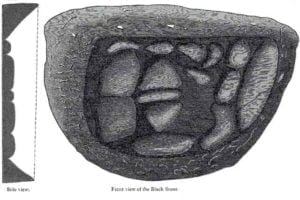
After the construction period was complete, Ibrahim was then instructed to call on his people to come on pilgrimage to it. As decreed by Allah, all Muslims had to make a pilgrimage to the house at least once in a lifetime until the Day of Judgment. In those days, pilgrims arrived on foot and camel. In the modern-day era, the faithful arrive by plane, bus, and car.
The black stone left by Ibrahim in the building is believed to date back to the time of Adam and Eve. It was later set into the wall by the prophet Muhammad in 605 CE. Later on, it was broken into fragments and cemented into the side of the Kaaba. (Traditionally, the belief is that the stone was part of a meteorite that fell to Earth. The Israelites of the time believed it to be a sign for a place where Adam and Eve should build an altar and later the first temple on Earth.)
Early Muslims believed that the stone of the Kaaba was white as snow, but was turned black by the sins of humankind. As the story goes, the Kaaba was lost during Noah’s flood but recovered by Ibrahim.
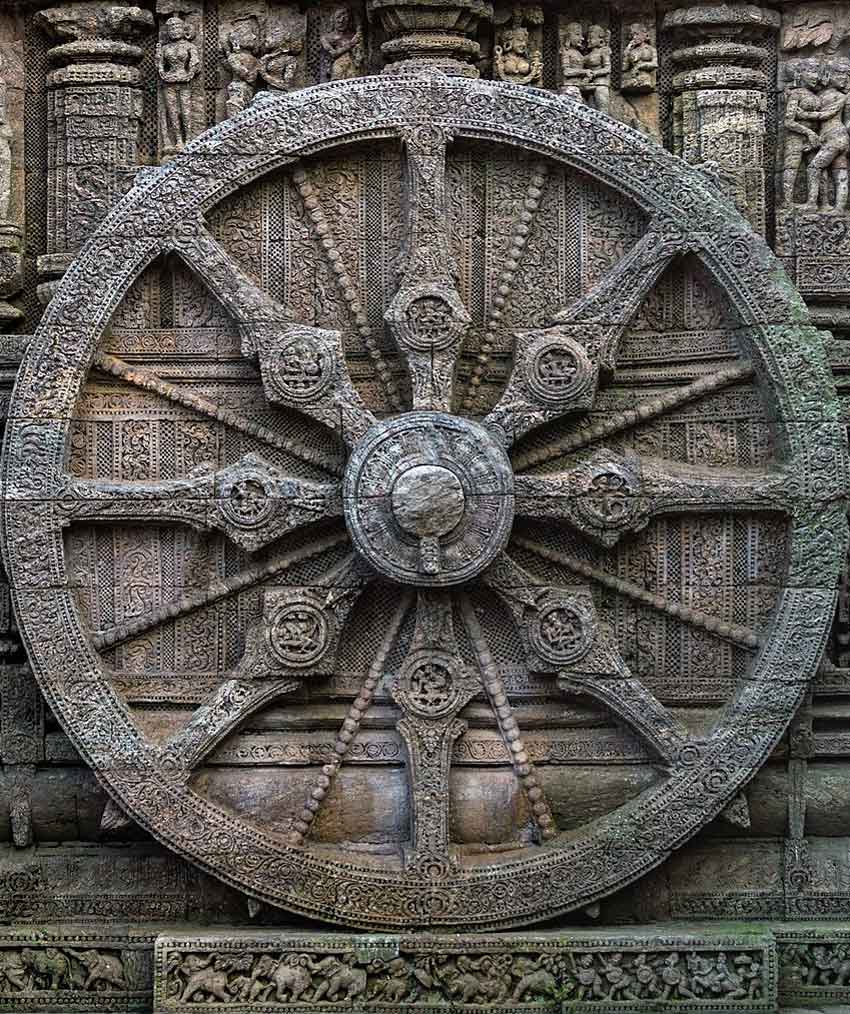
Photo Credit By Subhrajyoti07
THE WHEEL OF THE LAW
The Wheel of the Law (Dharmachakra) is one of the single most essential symbols in the Buddhist religion. To Buddhism, it has the same relevance as the Cross of Jesus to Christianity and the Star of David to Judaism.
Buddhism was founded by Siddhartha, a prince in the kingdom of Kapilavastu, located in the foothills of the Himalayas. Following a miraculous birth, it was predicted that he would become a universal conqueror of the human mind. Siddhartha sought the purpose of life and during a yogic meditation session, achieved enlightenment, and became the first Buddha known as the ‘Enlighten One.’
The Wheel of Law was discovered in Phra Pathom Chedi, located in the Nakhon Pathom province in Thailand sometime in 1939, but in 1981 it was relocated to the Phra Pathom Chedi National Museum in central Thailand. Here, The Wheel of Law was elevated onto a pillar, known today as the only pillar mounted Buddhist wheel in Southeast Asia.
Traditionally, the wheel’s circle represents perfection. The rim indicates mediation and the hub joy. There are various wheels within Buddhism, with anything from four to thirty-one spokes. (The Wheel of Law has four.) Inscriptions from Pali Canon on the wheel link it to the four truths of the Noble Ones, as related in the first sermon. These are the truths of suffering, the cause of suffering, the end of suffering, and the path to take to end the suffering.
Ironically, when Siddhartha woke up, (and as the first Buddha), he did not want to spread the Dharma to other people. He thought that humankind was so ignorant and hateful and that it would be beyond their grasp. It is believed that a certain Brahmā Sahampati convinced him that some humans would indeed recognize and understand it.
THE JONAH SARCOPHAGUS
Remarkable rock art appears on the sarcophagus of a 4th-century Christian from Rome by the name of Glycon. The artwork depicts scenes from the Book of Jonah.
The story of Jonah is well known in the Tanakh. Jonah was instructed by God to go to Nineveh and give them a message that their famed city will be destroyed because of their sins. Jonah tried to evade God’s instructions and fled on a ship. When a severe storm struck the ship, Jonah realized that it was entirely his fault. He then requested the seaman to dump him into the sea so that the storm could subside. This did happen, and Jonah was subsequently swallowed by a ‘big fish’ (whale) and spit out on a beach three days later. He realized his mistake there and then, and went on to complete the mission as per God’s instruction.
The artwork of the Glucon sarcophagus is not entirely true to the Bible, though. On the left, Jonah is cast overboard into the mouth of a terrifying fish or serpent sea monster. On the right, Jonah is cast ashore, where God provides him with a plant to teach him compassion.
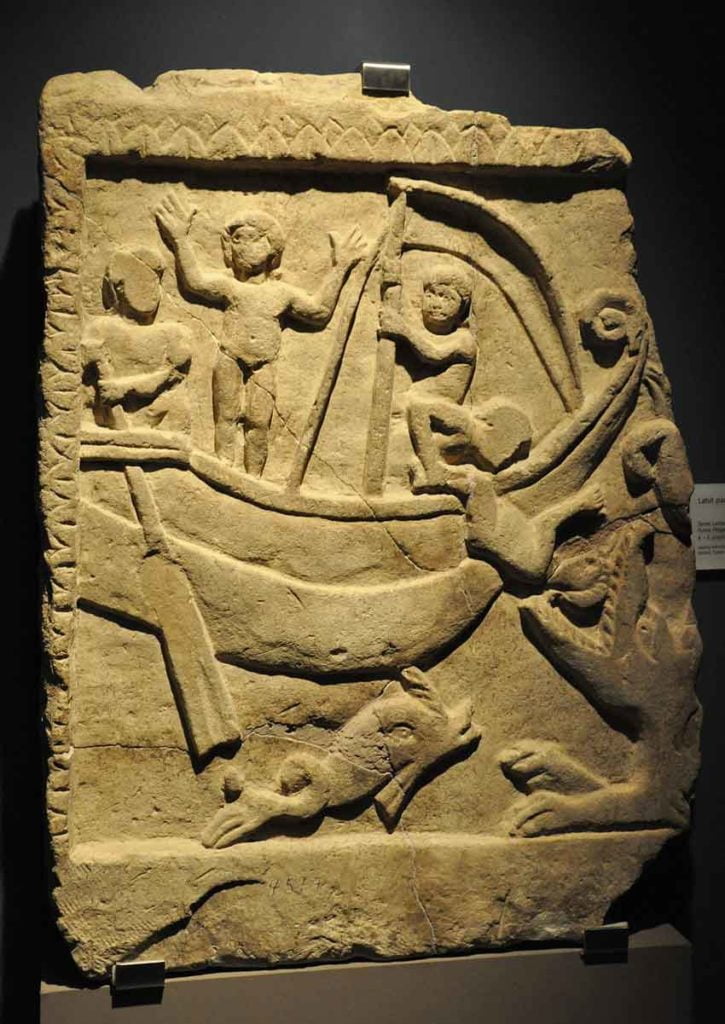
Photo credit: Bochum1805 on Visualhunt / CC BY-SA
The story of Jonah resurfaced in the Gospel of Matthew. Jonah is analogous to the resurrection: Jonah remained in the belly of the fish for three days, and the Son of God remained in the heart of the Earth for three days.
Remarkably, there is the unconfirmed story of James Bartley. A sperm whale swallowed him during a whaling expedition in the nineteenth century. Some 36 hours after his ordeal, he was cut from the belly of the whale by fellow fisherman and found to be still alive. His skin was a bleached white, and he was blind for the remainder of his life.
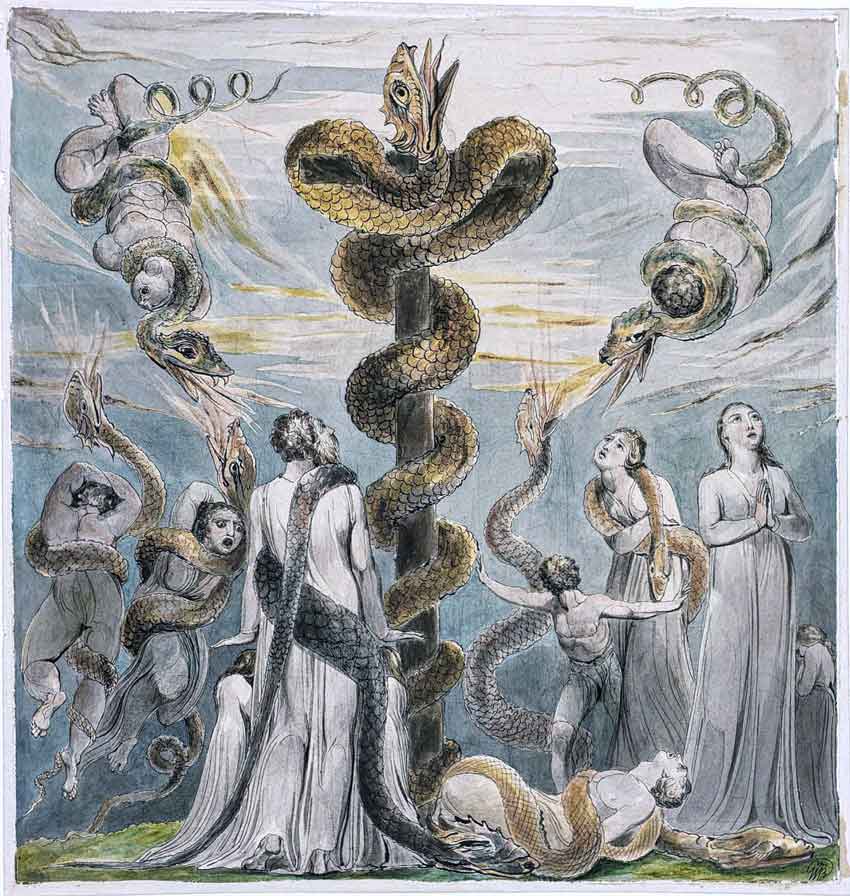
Photo Credit By William Blake
THE BRAZEN SERPENT
The Brazen Serpent was first mentioned in the book of Numbers in the Bible. The Israelites murmured against their God YHWH and the prophet Moses, and as judgment, God sent a plague of serpents amongst them. The Israelites repented and begged for YHWH’s forgiveness. Moses was then instructed by God to create a brazen serpent mounted on a pole. By walking past and looking up to the serpent, those who were faithful to God did not die when bitten by a snake.
The serpent was retained by the Israelites but later misused and worshipped as an idol called Nehushtan. Years later, the serpent was destroyed as part of the reforms instituted by King Hezekiah between 715 – 687 BC.
Seven similar so-called brazen serpents were subsequently discovered throughout the ages. All of them can probably be linked to the worshipping of Nehushtan. Interesting to note though is that the medical profession uses twin interwoven serpents as a symbol for medicine, very similar to that used by the ancient Israelites.
The world of religious artifacts is a magical and wondrous one with a fascinating story to tell if we are willing to explore and find it. Which famous religious relic would you love to uncover? Share your thoughts and comments with us below.
FDN LIFE >
AUTHOR
Ben Masterson
SUBSCRIBE TO
FDN LIFE NEWSLETTER!
Join our mailing list to receive the latest news, information, and special offers.

